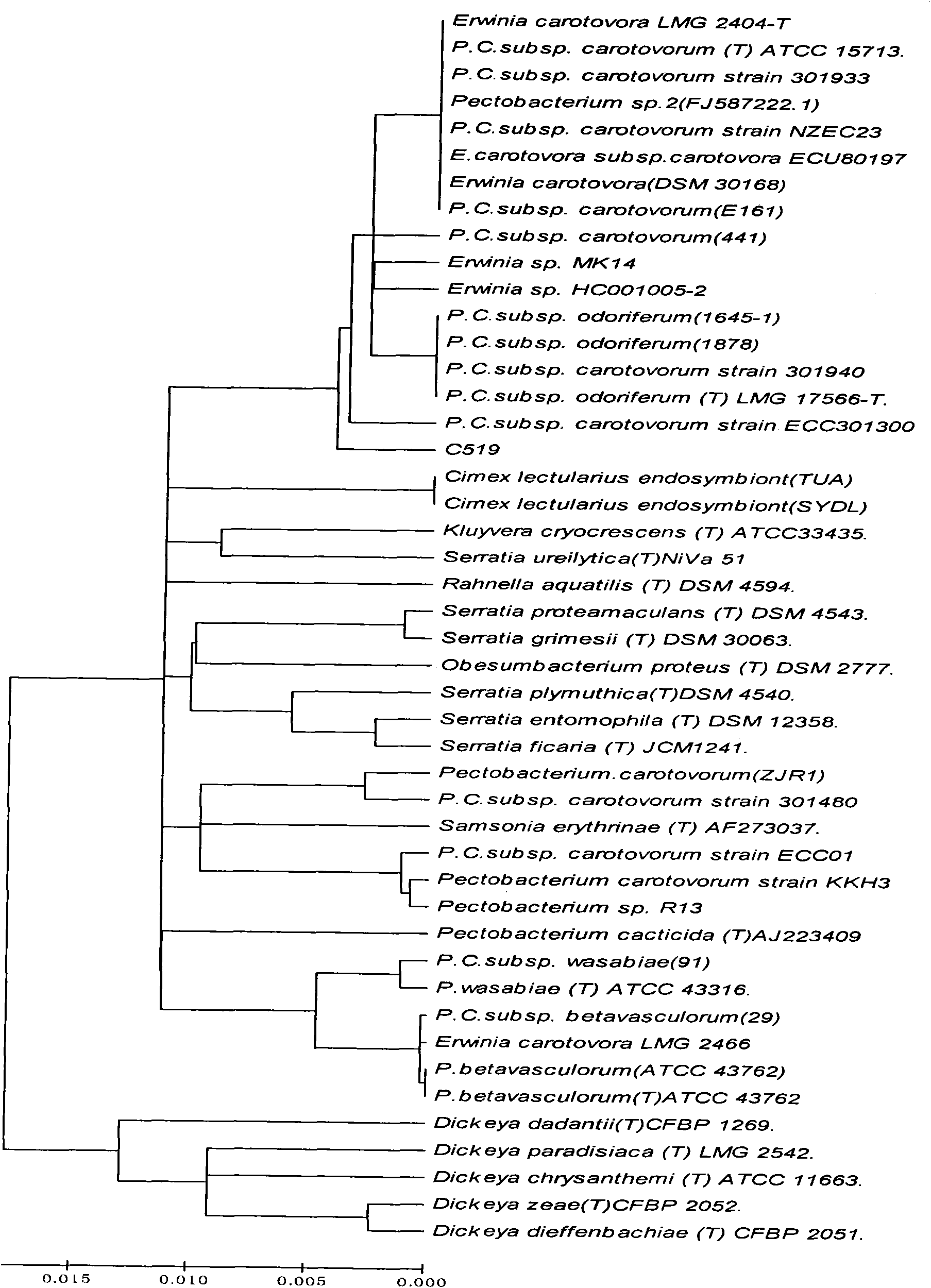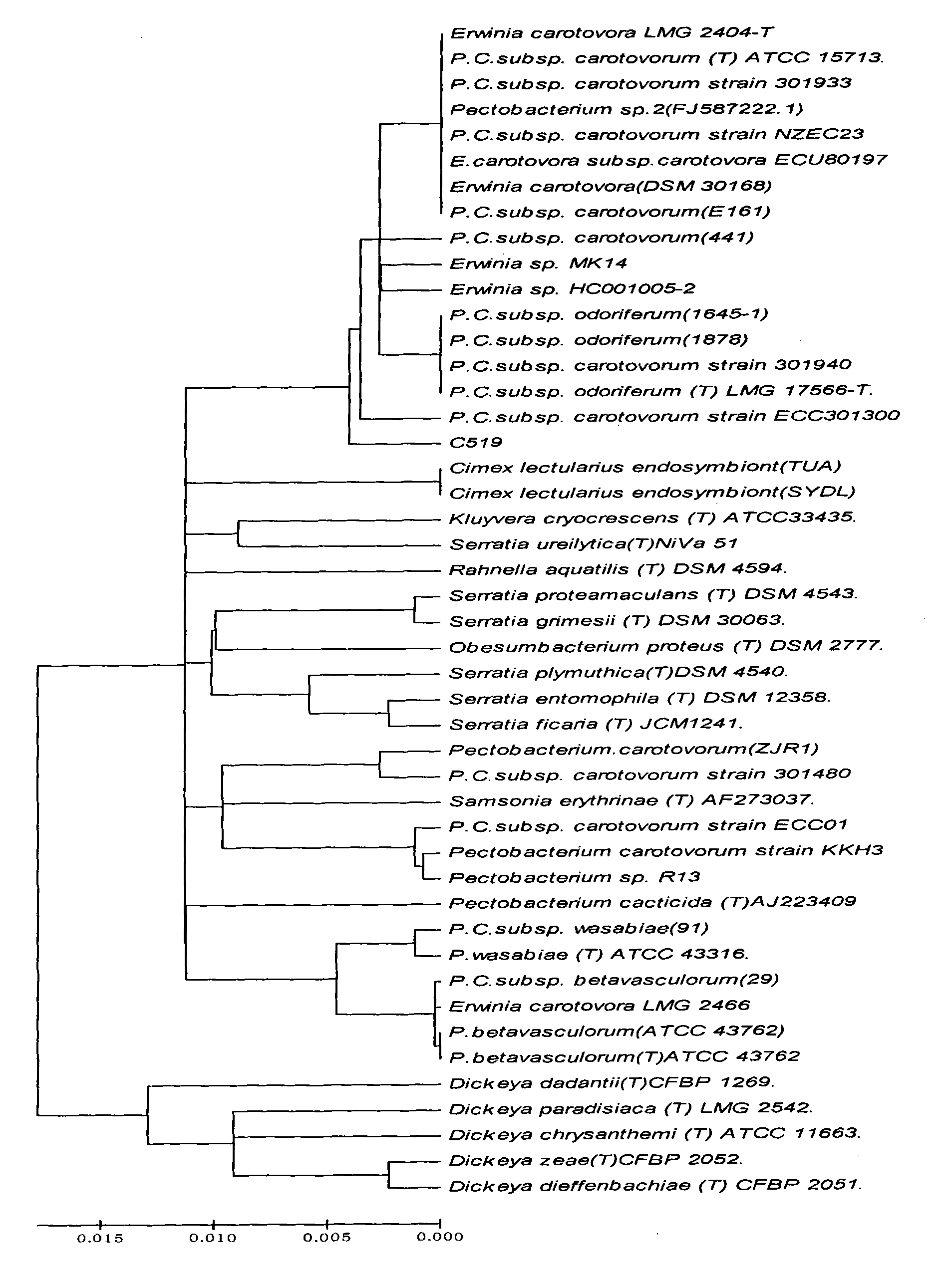Pectobacterium carotovorum and applications thereof in bio-pulping
A technology of pectin bacillus and soft rot pectin, applied in the field of papermaking, can solve the problems of cumbersome process and high production cost
- Summary
- Abstract
- Description
- Claims
- Application Information
AI Technical Summary
Problems solved by technology
Method used
Image
Examples
Embodiment 1
[0030] Embodiment 1 strain separation
[0031] Take the tissue with typical symptoms of soft rot in commercially available Chinese cabbage, cut off the edge with a sharp blade, soak in 70% alcohol for 2-3s, rinse 3 times with sterilized deionized water, and transfer to sterile 0.85% In normal saline, use a sterilized glass rod to mash the diseased tissue, and let it stand at room temperature for 10-15 minutes under aseptic conditions, then use a sterilized transplantation loop to dip the bacterial suspension into a line on an LB plate, and culture at 28°C 16-24hr. Pick a single colony for further streak culture, and transfer 6-7 times. According to the characteristics that Erwinia soft rot can produce deep depressions on crystal violet pectin medium (CVP), typical colonies were picked from the center of the depressions and streaked on LB medium, and a single colony was picked.
[0032] Preparation of crystal violet pectin medium (CVP):
[0033] In 500ml of boiled distilled ...
Embodiment 2
[0040] Embodiment 2 strain identification
[0041] 16SrDNA is the gene encoding prokaryotic ribosomal RNA small subunit 16S rRNA, with a length of 1540bp. It is the most commonly used and useful "molecular clock" in the study of bacterial taxonomy. There are 11 constant regions between them. Universal primers for bacteria can be designed according to conservation, and 16S rDNA fragments of all bacteria can be amplified. The variable region varies from bacterium to bacterium, and can reveal the characteristic nucleic acid sequence of biological species, which is the molecular basis for species identification.
[0042] The 16SrRNA of Pectinobacillus soft rot C519 (CGMCC No 3350) was extracted, and most of the sequence of the 16SrRNA gene of the bacterium was determined: 1445bp SEQ ID No.1.
[0043] Using the 16S rDNA sequence to classify the fungus by RDP comparison method, it was shown that the fungus was: Pectobacterium carotovorum subsp. carotovorum. Comparing the sequence...
Embodiment 3
[0048] (1) culture medium
[0049] ①Slant culture medium (%——g / 100ml, the unspecified components are water, the same below)
[0050] Pectin 2%, yeast extract 0.2%, ammonium chloride 0.2%, dipotassium hydrogen phosphate 0.1%, sodium carbonate 1%, agar 2%
[0051] ②Liquid medium
[0052] Peel and cut 200g of potatoes into slices, add to 1000ml of tap water, and boil for 30min. Filter through gauze; add 20 g of sucrose to the filtrate, and make the volume to 1000 ml; sterilize at 120°C for 15 minutes.
[0053] (2) Cultivation of C519 (CGMCC No 3350)
[0054] Inoculate the purified pectin bacillus soft rot C519 on the slant medium, culture at 30°C for 24 hours, then inoculate a ring of this bacteria in the liquid medium, 18 hours at 30°C, and shake the flask at a rotation speed of 180rpm.
[0055] (3) C519 (CGMCC No 3350) is used to separate fibers
[0056] The bark was cut into 10cm sections, immersed in tap water, the liquid-bark mass ratio was 1:5, and Na 2 CO 3 The pH v...
PUM
 Login to View More
Login to View More Abstract
Description
Claims
Application Information
 Login to View More
Login to View More - R&D
- Intellectual Property
- Life Sciences
- Materials
- Tech Scout
- Unparalleled Data Quality
- Higher Quality Content
- 60% Fewer Hallucinations
Browse by: Latest US Patents, China's latest patents, Technical Efficacy Thesaurus, Application Domain, Technology Topic, Popular Technical Reports.
© 2025 PatSnap. All rights reserved.Legal|Privacy policy|Modern Slavery Act Transparency Statement|Sitemap|About US| Contact US: help@patsnap.com


